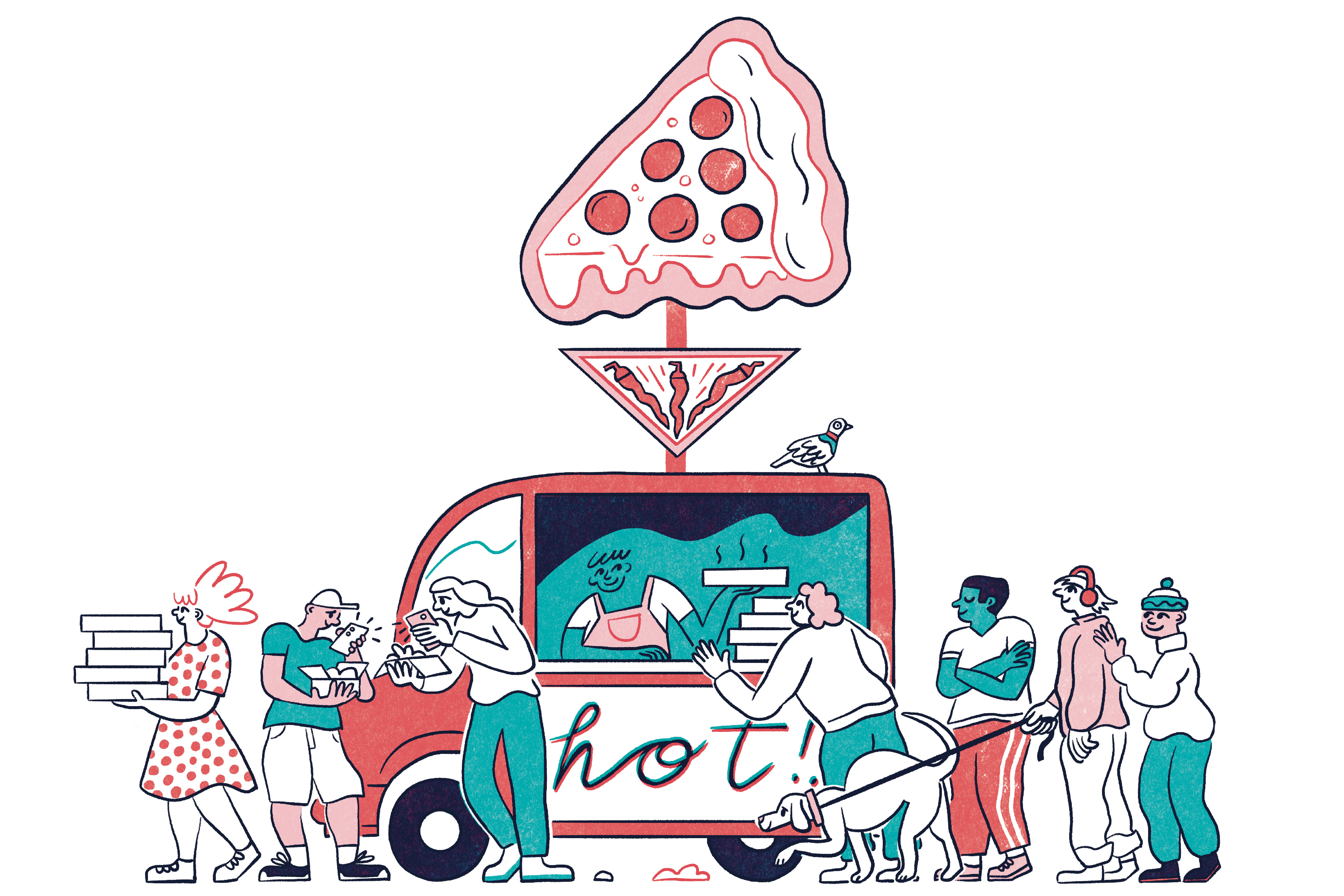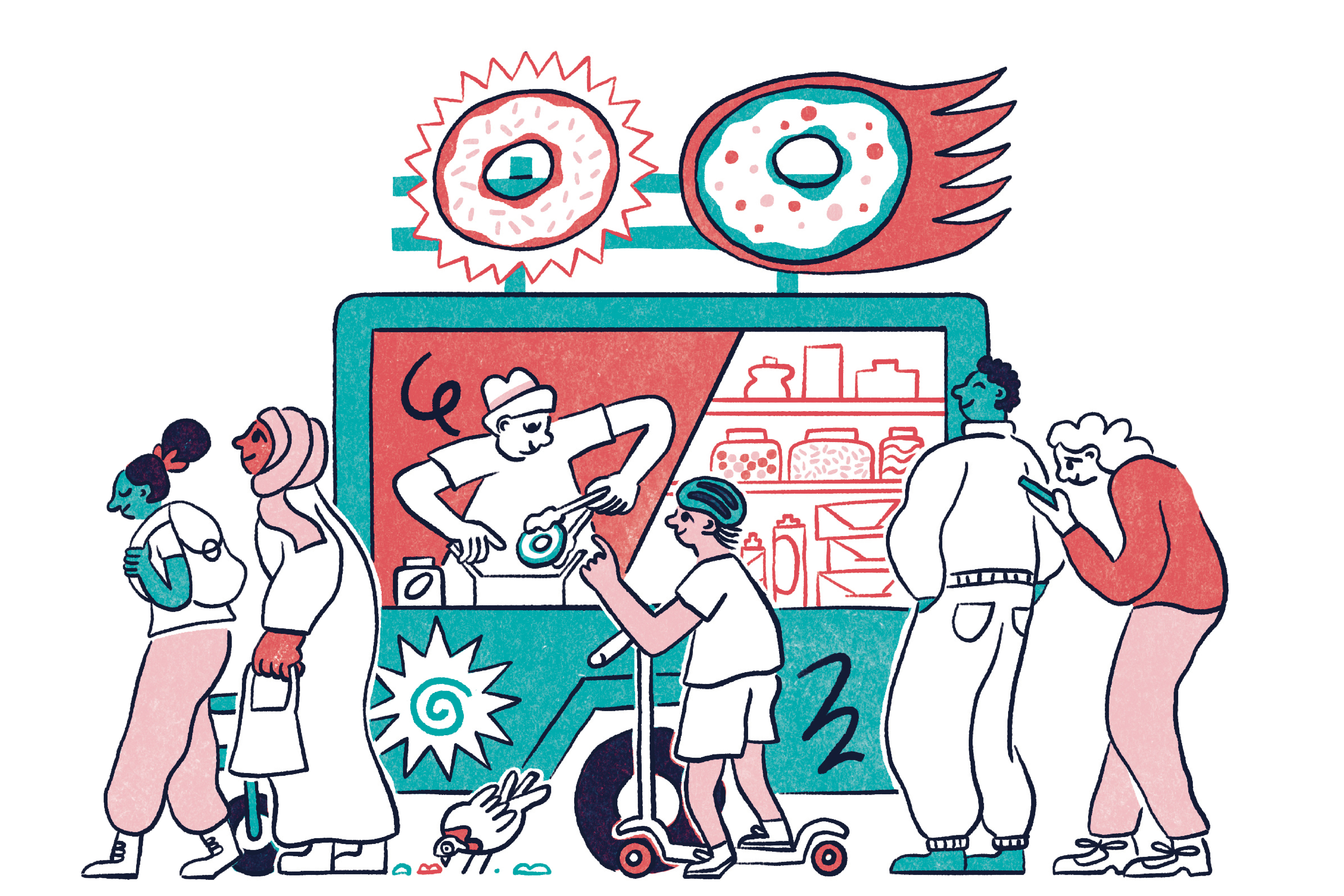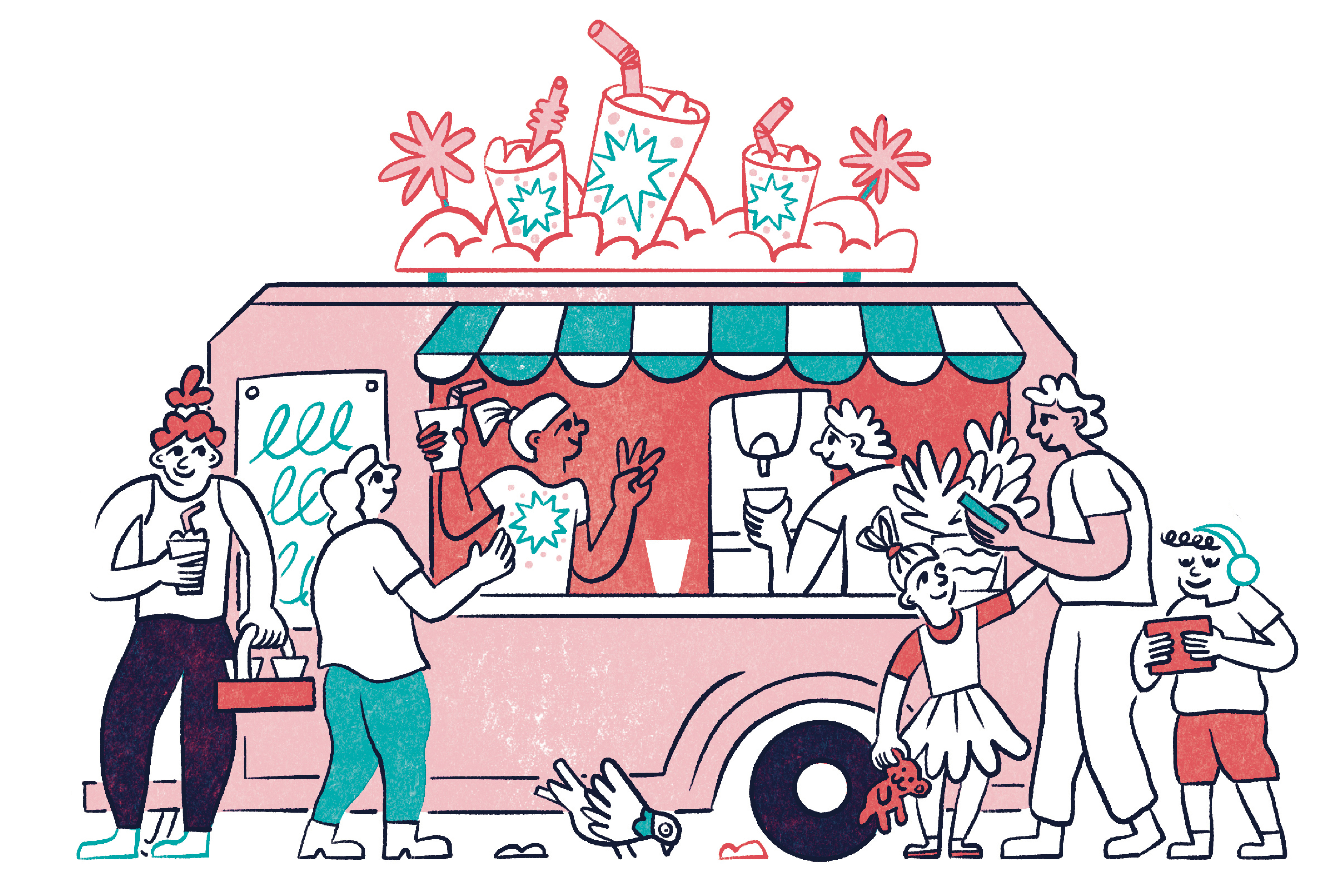Illustration by Dave Bain
As soon as I saw the TikTok videos of the chocolate-covered strawberries, I knew two things: that I was going to buy them, and that it would be a mistake. They’d shown up on my feed: effusive videos about completely average strawberries half-drowned in chocolate fondue. The videos were all pretty much the same. “People travel all over the world to get these chocolate-covered strawberries,” a disembodied voice would say over a pan shot of London’s crowded Borough Market. And then the camera would sweep across a queue – an ultra-concentrated throng of bodies, the line bunching up and coiling round. “This vendor uses milk chocolate to cover the freshest strawberries you’ll ever try,” the voice would go on. And then you saw the rows of clear plastic pint cups filled with strawberries, and there’d be a close-up as the cup went under the fondue tap, and the milk chocolate cloaked and pooled.
The money shot was the twist – rotating the cup for the camera, showing the cross-sections of chocolate and strawberry, something like the swivel and glance-back of a model on the runway. “The result,” the voice would say, “is ooey, gooey, delicious warm chocolate over cold strawberries, which is why” – and this is where TikTok loops the video – “people travel all over the world to get these chocolate-covered strawberries.” It was an obvious thing to do; a time-tested combination of ingredients, executed without any particular flair. In a food culture of almost mandated novelty, maybe this is why it worked, even though it costs – and I need to stress this – nearly £10.
The algorithm brought these videos to me tenderly but insistently, the way a cat drops a dead mouse on the carpet. I was hooked. The viral strawberries, people were calling them. Some people made videos like game walk-throughs – routes, menu hacks, prices and ways to beat the queue. Others gave hard data: 20 minutes to find the stall, 40 people ahead of them in the queue, no more than a few minutes before reaching the front, overall 9/10 rating. The videos were mostly American or Australian, but there were splinter factions from Germany and the Netherlands. Some had voiceovers in Arabic and prices converted to UAE dirham. The wilder the ratio of effort to payoff, the better. “I flew eight hours to try the most viral strawberries in the world,” they said. Or “POV: u saw the tiktok so you came from Australia for the strawbs”. Depending on the whims of the algorithm that day, a video like this could get anywhere between just 10 and 10m views. Have I mentioned that the strawberries looked, at best … fine?
This was unserious food for unserious people and tourists and suckers and kids
In the olden days, you needed a newspaper critic to pull a crowd like this. How else, except through a write-up in a paper with a few hundred thousand daily readers, could you create a scrum for something like fruit in a cup? And then, demagogues like TikTok food reviewer Keith Lee perfected a different kind of hype that was more relatable and tapped into appetites of the novelty-seeking internet. The foods and the style were radically different, but both ways of talking about restaurants ultimately relied on the cultural heft of whoever was doing the talking.
In any case, somebody has authority – innate or bestowed, soft or absolute – and this is all that counts.
But the strawberries were different. There were no reviews or write-ups in the Best Of lists or Time Out clippings to tape up in a shop window. This was unserious food for unserious people and tourists and suckers and kids. When I talked to friends who are food writers and semi-pro opinion-havers on the London food circuit, none had tried the strawberries and some didn’t even know they existed. I had heard about the strawberries, but only through the splintered channels of my social media algorithms. Hundreds of thousands of customers, millions of strawberries, tens of millions of video views – the strawberries were an internationally famous, runaway success of the London food scene for about two years – and not one authorised tastemaker was involved.
The whole thing, it seemed to me, worked like a murmuration of starlings – the crowd following a logic that nobody inside it fully understood. Each video was the impetus for more pilgrimages, many of which ended up on social media themselves. Who knows what inspired it, or who exactly it inspired. It doesn’t matter. Things here proliferate in a non-linear way, spreading exponentially and concentrically around the facts. “After seeing these viral chocolate strawberries, I had to see if they were worth the hype,” someone will post. This is it – the surge, the quantum mechanics of hype.
I joined the other hundreds of people going to Borough Market that day with the strawberries in mind. I did this while feeling superior, and then I worked my way through the same congested market as everyone else, and went through the democratic embarrassment of queuing for a TikTok-viral food. I paid with the same pounds sterling. Then I found a spot next to a bin, where a few other strawberry people had come with their cups and their wooden sporks. People took a few videos, which I’m sure they posted online. We ate, and spilled chocolate down ourselves, and rubbed the chocolate deeper into our clothes with ineffective paper napkins. I probably don’t need to tell you that the strawberries were average, but what difference would it make? At the time of writing, the strawberries have been viewed more than 150m times on TikTok alone.
A lot of my decisions come down to: what are they having over there?
It should be obvious by now that appetite is social – that we rely on the judgment of people who’ve been there and eaten that before us. Maybe what’s less obvious, or at least what we’re less willing to admit, is how often these people we trust are people who know as little as we do and sometimes even less. People like our parents. And if it isn’t your parents, it’s your friends, or the ambient pressure to eat the same things as the other kids at school. As an adult with disposable income and an intense interest in food, a lot of my decisions come down to nothing more complicated than: what are they having over there?
You see it in restaurant queues. Go to a tourist area in any city in the world and you’ll see people deciding which restaurant to go to not by looking at the menu but by sizing up the line. This is the paradox of queues: the longer they are, the more people want to join them. The basic principles are simple: if all those people are doing it, then it must be good; and if it’s good, then I should be doing it too. A queue, in its most basic form, is an expression of supply and demand. But recently queues have mutated. If you’ve been paying any attention at all to restaurants in the past 30 years, you’ll know that there are now two main characters in every hit restaurant story: the chef, and the queue, and often the queue has the more personality of the two. In London, in just the last couple of years, people have talked about the strawberry queue, the Toad Bakery queue, the Knoops hot chocolate queue, the queue for loaded chips at Camden Market, the Dishoom queue.
Forget critics or influencers or PRs – the best representation a restaurant can dream of is a line. And the more that people hate the line, the more they complain about it, the more powerful it becomes.
Hype hasn’t always been this visible. In the 1980s, say, chances are that you’d have to call to make a booking for a buzzy restaurant. Whether or not you got the table, that was your business, but you certainly never had to do anything as conspicuous as standing in a line. But in the 1990s, an emerging genre of restaurant pivoted towards a more casual way of doing things with no-frills service and, crucially, no reservations. Taste seemed to settle on an egalitarian-feeling type of casual, middlebrow restaurant. Everyone is equally welcome here, they said, by which they meant that everybody was welcome to join the queue. But it was fun, feeling a part of the buzz. One of the first of this type of line in London was for Wagamama, a noodle bar which opened in 1992 and which people mainly remembered for the communal tables and how fast it was. Before the reviews or the write-ups in the guidebooks, the first big advert was the line trailing down the street.

Still, it’s New York that does this best. In 2001, Shake Shack opened as a summertime hot dog cart in Madison Square Park, and gradually built the kind of queues that would have you thinking, if you didn’t know better, that it was hard to find a hot dog in New York. In 2004, the business settled into a small, purpose-built kiosk in the shade of an old elm tree, and expanded the menu to serve burgers and shakes and crinkle-cut fries. Over the next couple of summers, the queue started to develop a personality of its own. People were queuing from 11am, hovering near the kiosk, pretending to read a paper or wait for friends. It had energy. It was the rare line that people were happy, even eager, to be in.
By 2006, the word about Shake Shack had spread, and the queues – for what was still just a lunchtime burger place in a small public park – could stretch 100 people deep. Management was required, with signs directing people through the route. The queue no longer just had a personality, it had a reputation, a crew of minders and managers, and a cult following of its own. A fan site, ShackWatchers, was set up to monitor the line. You could, in the most mid-2000s internet transaction imaginable, take a blurry photo of the line with your Blackberry phone and upload it to Flickr with the tag “shakeshackline”. These photos were shared on the site, the most recent first, making it a kind of manual webcam. And then the actual webcam happened, on the official Shake Shack website: a feed that refreshed every five to 15 seconds, showing the line in real time. At first, Shake Shack management thought it was a horrible idea. If they see a line, they said, people won’t go there. But the cam got tens of thousands of hits each week. “It was meant to be a service,” Pete Wells, until recently the restaurant critic for the New York Times, told me. You could check the webcam – presumably on your office computer, because realistically who had a phone that could handle this much data? – and then go when the line was short. “But it was also,” he added, “the beginning of the celebration of the line.”
It’s strange to think that the blueprint for the Borough Market strawberries was set way back in 2006, a year before the first iPhone. “Lines are so central to the Shake Shack experience that they have symbolic overtones,” Wells wrote, a few years into the Shake Shack era. “The line is democratic … It is a signal of freshness: everybody waits, because the food is cooked to order. It is the people’s endorsement: everybody waits, so it must be worth it.” This mattered, for a vernacular American food that couldn’t bank on receiving a serious New York Times review – until Wells did it himself. Such things sometimes got mentioned in diary pieces and burger round-ups, but they were never given the critical close-read of, say, a midtown, sit-down restaurant. And so the queue became the critic, and the internet spread the word.
There was one more thing. In the mid-to-late 2000s, food blogs started to grow. A whole ecosystem of mostly hobbyist food bloggers started talking about restaurants online, cross-referencing each other and competing to outpace the hype. These bloggers did the combined job of newspaper gossip columnist, restaurant critic, local reporter and opinion writer, and at breakneck pace. At the same time, online food publications were having a miniature golden age. Where once you’d have to buy the newspaper, and search for the microprint restaurant review, now you had a constant stream of food media content – and naturally, everyone was writing about the line.
By 2013, these feedback loops had been expertly calibrated to create hype. And so, when Dominique Ansel developed his recipe for the cronut – a deep-fried doughnut ring, but made of croissant dough – people were reporting on it, and anticipating the appetite for it, before it even launched. It wasn’t just the line, which started forming from 6am, two hours before the bakery even opened, or the scalpers, who queued for hours and resold the cronuts for profit to “I’m not a morning person” people. It was the media – Grub Street, Eater, the Times, the Village Voice, the Week, Huffington Post, the Atlantic, all of them feeding the ego of the queue, and all of them, in a weird way, dependent on it. Cronuts became, in the end, the most famous hype food of the 2010s.
A lot of it was timing: they came at the height of super-intense restaurant coverage, but also at the dawn of a new, more adaptive, more instinctive kind of media. Instagram was launched in 2010 and by the time of the cronut-inception event it had about 100m users. On Instagram, you shared a photo of the food with an explanatory caption, rather than a blog post about the food with an illustrative photo. This allowed you to bypass thinking altogether and just look: burgers, hot dogs, fries, pizza, ice-cream, cake, bubble tea – all those foods that instantly register as delicious. “What we’re talking about,” Wells explained, “is a shift from talking about places, venues, establishments and addresses, to a single experience.” Nobody was talking about Dominique Ansel’s bakery, which would have involved thinking about what kind of place it was and how it dovetailed into the New York scene. People just shared the cronut, a platonic torus of golden dough with a sugar-salt-fat ratio to please the gods. The cronut – a singularity. Instead of spreading through word of mouth, it spread exponentially, like a contagion, and the template was laid for the next 15 years of viral restaurant trends.

Since the cronut, we’ve been living through an age of serial virality. We find ourselves now surrounded by lines, usually for inexpensive, seemingly democratic foods in the Shake Shack mould. In the past few years, TikTok, in particular, has become the platform for viral food. Traditionally, social media platforms emphasised the social. This meant following friends or family or celebrities, and mainly being shown their content. Restaurant influencers became a thing, and people trusted in their authority the same way they used to trust the critics. TikTok, and the apps that have followed its lead, are different. The beat falls on the media, not the social. The For You page is an algorithmically curated scroll of videos. It doesn’t matter who posted something or how many followers they have or whether you even know them. The important thing is the content – does it make people linger? Do people send it on? Does it do its job? Its job, by the way, is to keep people scrolling the app, not necessarily to lead them to good food. This recommendation algorithm may be the most powerful tastemaker in the world right now. Some of the most viral foods in London in the last couple of years include a foot-long croissant, a brick of honey butter toast and cookies thicker than the average burger. A more-is-more principle is in effect. It has led to mashups like birria ramen, cheeseburger tacos, cruffins, crookies and brookies. When something goes viral on here, it reveals something about the things we really want. And w hat people want, it turns out, are easily digestible food ideas – things they already know, like the burger, and hybrids that they double know but that are also novel, like the “yorkshire pudding burrito”.
After what felt like a week, I got the chips. Terrible
We have got to a point now where even restaurant critics follow the queues, following the lines of people, who themselves are following the online hype. Influence is being broken, or it’s being fixed. The balance of power is moving towards the simple rubric of likes, sends, hearts, forwards, views, headcounts in a queue. This is the maths of the fear of missing out, and it’s responsible for 80% of my biggest food mistakes.
In Camden Market, there is a stall where you can buy loaded chips. The people in front of me were there thanks to TikTok. The people behind were, too. We all waited in the queue, watching videos of queues strikingly similar to the one we were stuck in. And then, after what felt like a week, I got the chips, which had been tossed with mayonnaise, grated cheese, a spice and herb mixture, chilli sauce and jalapeños. They were terrible, but then you already know that. I complained about the chips and the line to anybody who would listen, including my dry cleaner – and as it happened, he had gone there too. Never again, I said. Never again, he agreed. And I left the shop, and opened TikTok on my phone.
This is an edited extract from All Consuming: Why We Eat the Way We Eat Now by Ruby Tandoh (Serpent's Tail, £18.99), published on 4 September. Order a copy for £17.09 at observershop.co.uk
